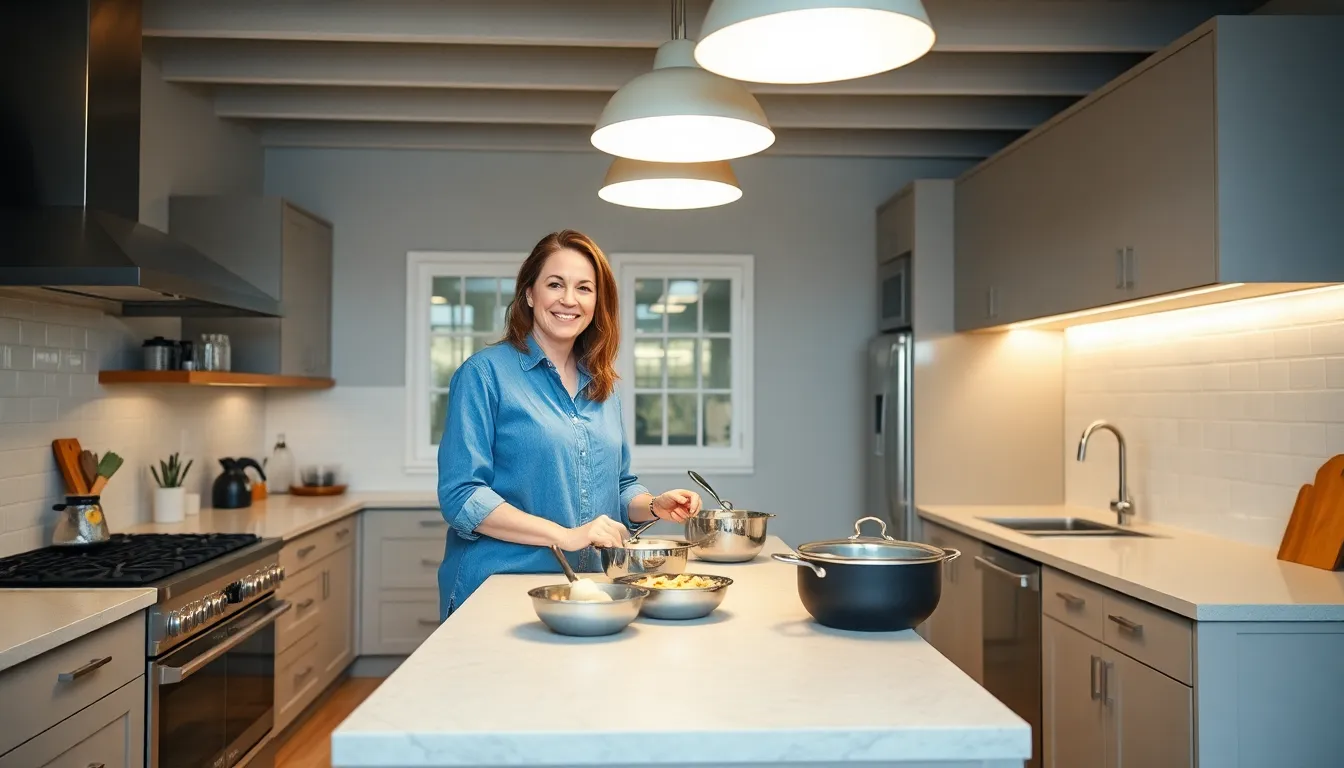Imagine whipping up a gourmet meal without the backache that usually comes with it. Ergonomic kitchen design isn’t just a fancy buzzword; it’s the secret sauce to transforming a mundane cooking space into a haven of comfort and efficiency. With the right layout and tools, anyone can channel their inner chef without sacrificing their well-being.
Table of Contents
ToggleOverview of Ergonomic Kitchen Design
Ergonomic kitchen design focuses on creating spaces that maximize comfort and efficiency during meal preparation. Essential elements include work surfaces at the correct height, which reduces strain on the back and arms. Workstations should be easily accessible, allowing for seamless movement between cooking, cleaning, and storing.
Arrangement plays a crucial role in this design. The “kitchen work triangle” concept ensures the refrigerator, stove, and sink form an efficient layout. This configuration minimizes unnecessary steps, allowing for a smoother cooking process. Consider the use of pull-out shelves and drawers to make items easily reachable, further enhancing organization.
Tools and appliances also contribute significantly to ergonomics. For instance, selecting lightweight cookware reduces fatigue during cooking. Ergonomically designed handles on utensils provide a comfortable grip, minimizing the risk of injury.
Lighting cannot be overlooked. Bright, focused lighting enhances visibility, making it easier to prepare food safely. Under-cabinet lights or pendant lights over work areas help pinpoint tasks, reducing mistakes and accidents.
Incorporating adjustable furniture is another way to support ergonomic principles. Height-adjustable tables or islands allow users to work sitting or standing, accommodating various tasks comfortably. Such flexibility accommodates different user preferences and physical needs, ensuring longevity in design usability.
To achieve the best results with ergonomic kitchen design, early planning is essential. A well-designed kitchen not only facilitates cooking but also promotes enjoyment and creativity. Prioritizing these features ultimately leads to a more satisfying culinary experience, free from stress or discomfort.
Key Principles of Ergonomic Kitchen Design

Ergonomic kitchen design prioritizes comfort, safety, efficiency, and workflow. Implementing the following principles enhances cooking experiences and ensures user well-being.
Comfort and Safety
Comfort plays a vital role in kitchen design. Adjustable work surfaces accommodate varying heights, promoting good posture while cooking. Adequate lighting reduces eye strain, ensuring tasks are performed safely. Using lightweight cookware minimizes the risk of injuries. Attention to anti-slip flooring lowers the chances of accidents, especially when handling liquids. Ergonomically designed utensils contribute to a secure grip, reducing fatigue during food preparation.
Efficiency and Workflow
Efficiency hinges on the layout and organization of a kitchen. Placing frequently used items within arm’s reach reduces unnecessary movements. A well-planned kitchen work triangle connects the stove, sink, and refrigerator, streamlining meal preparation. Organizing storage areas by grouping similar items enhances accessibility. Creating clear pathways invites easy navigation between stations. Integrating multifunctional tools maximizes space while maintaining functionality.
Components of an Ergonomic Kitchen
An ergonomic kitchen incorporates various components that enhance comfort and efficiency during cooking. Each aspect plays a crucial role in minimizing strain and improving workflow.
Counter Heights and Layout
Counter heights significantly influence user comfort. The ideal height aligns with the user’s stature to reduce bending or reaching. A standard counter height of 36 inches works for most individuals, while adjustable options cater to different heights. Layouts should promote smooth transitions between work areas, ensuring easy access from the stove to the sink and refrigerator. A U-shaped or L-shaped design often maximizes space and enhances movement for multiple users.
Appliance Placement
Strategic appliance placement optimizes kitchen functionality. Positioning the refrigerator, stove, and sink within easy reach facilitates quick meal preparation. It’s beneficial to place frequently used appliances, like microwaves, at counter height to minimize strain. Keeping similar appliances together helps streamline tasks, while maintaining clear pathways allows users to move unhindered throughout the kitchen. Design should also account for accessibility, ensuring that all users can interact comfortably with the appliances.
Storage Solutions
Effective storage solutions enhance organization and efficiency. Cabinets should feature pull-out shelves to reduce bending and reaching, while deep drawers can hold pots and pans securely. Open shelving enables quick access to frequently used items, which can save time during meal prep. Vertical storage containers maximize space usage and keep items visible. Incorporating labeled containers helps maintain order, allowing users to find essentials quickly, fostering a seamless cooking experience.
Benefits of Ergonomic Kitchen Design
Ergonomic kitchen design offers numerous advantages, making cooking and meal preparation more enjoyable and efficient. Individuals who adopt this approach often experience notable benefits in their daily activities.
Health and Wellness Improvements
Comfort becomes a priority in an ergonomic kitchen. Proper counter heights can reduce strain on the back and joints. Customized features, including adjustable work surfaces, promote good posture. Reduced physical strain translates to fewer injuries and long-term health issues. Lightweight cookware decreases fatigue during meal preparation. Effective lighting enhances visibility, preventing accidents while cooking. When individuals can access tools easily, the likelihood of overreaching or awkward movements diminishes. Consequently, health improves, allowing for a more pleasant cooking experience.
Increased Productivity
Productivity increases significantly with an ergonomic kitchen design. Streamlined layouts minimize unnecessary steps, making cooking tasks faster and easier. The kitchen work triangle ensures optimal access to essential appliances. When frequently used items are within reach, chefs save valuable time. Adjustable workstations also accommodate various tasks, making transitions smoother. Integrating multifunctional tools reduces clutter and enhances efficiency. Additionally, organized storage solutions promote quick access to ingredients and utensils. As a result, individuals can create meals in less time, maximizing their culinary experience.
Embracing ergonomic kitchen design transforms cooking from a chore into an enjoyable experience. By prioritizing comfort and efficiency, individuals can create a space that not only enhances productivity but also promotes wellness. Thoughtful layouts and the right tools minimize strain and injury risk, allowing for a seamless flow between tasks.
Investing in adjustable surfaces and effective storage solutions further streamlines meal preparation. This approach fosters creativity and enjoyment in the kitchen, making cooking a more fulfilling activity. Ultimately, a well-designed ergonomic kitchen is key to elevating both the culinary experience and overall quality of life.







